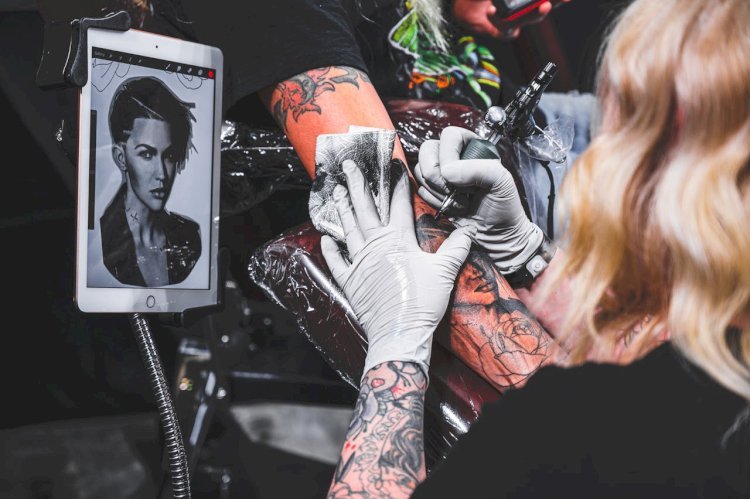How to Become a Tattoo Artist in 2025: Step-by-Step Career Guide
Learn how to become a tattoo artist in 2025 with this step-by-step guide — training, tools, salary, licensing, and growth tips for aspiring professionals.

If you’ve ever dreamed of turning your creativity into body art, becoming a tattoo artist could be your perfect calling. Tattoos are no longer just counterculture — they’re a mainstream form of self-expression. In 2025, the global tattoo industry continues to grow, driven by demand for customized designs, advanced equipment, and safe, hygienic studios.
This step-by-step career guide explains how to become a tattoo artist — covering everything from learning to draw and finding an apprenticeship to getting licensed and earning your first income. Whether you’re a beginner or an artist transitioning into tattooing, this roadmap will help you turn your passion into a professional career.
Understand What a Tattoo Artist Really Does
Before diving in, understand what being a tattoo artist actually involves. It’s far more than just drawing cool designs — it’s a mix of artistry, precision, hygiene, and client trust.
A professional tattoo artist:
-
Creates custom tattoo designs based on client requests
-
Operates tattoo machines safely and efficiently
-
Practices strict sanitation and sterilization
-
Offers aftercare instructions and follows hygiene laws
-
Builds long-term relationships with clients
Tattooing is a skilled trade and a lifelong learning journey. You’ll need to develop patience, creativity, and an eye for detail.
Build Artistic Skills Before You Pick Up a Needle
The foundation of tattooing is artistic ability. Start by sharpening your drawing and design skills. You don’t need to be a master illustrator at first — but you must understand anatomy, composition, and color balance.
Ways to build your skills:
-
Sketch daily — practice lettering, shading, and realistic designs
-
Use drawing tablets or apps like Procreate to digitize your art
-
Study tattoo styles like realism, traditional, tribal, Japanese, or geometric
-
Practice on fake skins or silicone models before touching real skin
Taking art classes or online courses can also refine your technique. The more original your designs are, the faster you’ll stand out as a tattoo artist.
Get the Right Education and Tattoo Training
While you don’t need a college degree to start a tattoo artist career, having proper art education or certification boosts your credibility.
Educational Paths for Tattoo Artists
| Learning Path | Duration | Key Focus | Average Cost |
|---|---|---|---|
| Art School | 2–4 years | Drawing, design, anatomy | $10,000–$30,000 |
| Tattoo Workshop | 1–6 months | Technique, hygiene, equipment | $500–$2,000 |
| Online Courses | Self-paced | Basics of tattooing & safety | $50–$300 |
You can find online tattoo training programs in 2025 through platforms like Skillshare, Udemy, or Coursera, focusing on hygiene, color theory, and digital design.
Formal art training will help you understand human anatomy and skin behavior — crucial for making tattoos look good and last long.
Find a Tattoo Apprenticeship (Your Real Training Ground)
The most important step in learning how to become a tattoo artist is securing a tattoo apprenticeship. This is where you learn hands-on under an experienced professional.
Here’s how to get started:
-
Build a strong portfolio of your best artwork — both on paper and digitally.
-
Research local tattoo studios with reputable mentors.
-
Approach professionally — show humility, respect, and a willingness to learn.
-
Be patient — apprenticeships often last 1–3 years.
During this period, you’ll:
-
Observe your mentor tattooing clients
-
Learn studio hygiene and setup
-
Clean workstations and prepare equipment
-
Practice linework under supervision
Tip: Treat your apprenticeship like college — respect your mentor, stay consistent, and absorb everything.
Learn Tattoo Equipment & Hygiene Standards
Every professional tattoo artist must understand their tools. Tattooing involves technical precision — and hygiene is everything.
Essential Tattoo Equipment List
| Equipment | Purpose |
|---|---|
| Tattoo Machine (Coil or Rotary) | Main device for tattooing |
| Power Supply | Controls voltage and performance |
| Needles & Cartridges | For outlining and shading |
| Inks | Provide pigmentation for designs |
| Autoclave | Sterilizes reusable tools |
| Gloves & Disinfectants | Maintain hygiene and safety |
Hygiene rules:
-
Always use sterilized needles.
-
Wear disposable gloves.
-
Disinfect every surface and tool before and after use.
-
Dispose of waste responsibly.
Alt-text: “Professional tattoo artist equipment setup with machine, needles, and inks.”
Get Licensed and Certified (Legal Requirements for 2025)
Tattooing involves skin penetration, so proper licensing is mandatory. Requirements vary by region, but most include:
-
Bloodborne Pathogens Certification
-
Health Department Inspection
-
Proof of Apprenticeship Hours
-
ID and Registration with Local Council or State Board
Examples:
-
United States: Each state has its own tattoo licensing authority.
-
United Kingdom: Artists must register with the local council under the Tattooing of Minors Act.
-
Australia/Canada: Require public health certification and proof of safe practices.
Check your region’s official regulations before tattooing clients.
Alt-text: “Certified tattoo artist displaying health and safety license in studio.”
Start Working Professionally
Once you’re licensed, it’s time to earn. You can either work for an established studio or start your own tattoo business.
Tips for Starting Strong:
-
Build your brand identity — logo, name, and social media presence
-
Showcase your portfolio on Instagram, TikTok, or Pinterest
-
Offer discounts to attract your first clients
-
Ensure every session follows top hygiene and professionalism
-
Ask clients for reviews and referrals
If you’re business-minded, consider renting a booth or opening your own studio. You’ll need to comply with local regulations, invest in insurance, and create a welcoming, sanitary workspace.
Alt-text: “Tattoo artist consulting with client about design before starting the tattoo.”
Tattoo Artist Salary and Income Potential in 2025
Your income as a tattoo artist depends on experience, reputation, and location.
Average Tattoo Artist Salary (2025 Estimates)
| Experience Level | Average Annual Income | Notes |
|---|---|---|
| Apprentice | $15,000–$25,000 | Learning stage |
| Junior Artist (1–3 years) | $30,000–$60,000 | Studio-based |
| Experienced Artist | $70,000–$120,000+ | May own a studio or brand |
| Celebrity/Influencer Artist | $150,000–$300,000+ | Endorsements, global clients |
Income can also grow through social media branding, selling art prints, teaching workshops, or collaborating with clothing brands.
Grow Your Tattoo Career in 2025 and Beyond
Tattooing is an evolving art form — and staying updated keeps you relevant.
Career Growth Tips:
-
Attend tattoo conventions to network and learn new styles
-
Follow leading artists on Instagram for inspiration
-
Collaborate with influencers and photographers
-
Start selling tattoo-themed merchandise or online courses
-
Learn modern techniques like UV ink and 3D realism
The future of tattooing includes digital design previews, AI-assisted pattern creation, and advanced healing inks. Embrace innovation and your career will thrive.
Read More: Feet Photography for Money: How to Earn from Your Pictures in 2025
FAQs About How to Become a Tattoo Artist
Q1. How long does it take to become a tattoo artist?
It typically takes 2–4 years, including your apprenticeship and skill development.
Q2. Do I need to be good at drawing?
Yes — drawing is the foundation of tattoo art. Clients expect originality and precision.
Q3. Can I learn tattooing online?
You can start learning theory and hygiene online, but hands-on experience is essential.
Q4. How much does beginner tattoo equipment cost?
A good-quality starter kit ranges between $500–$1,500.
Q5. Is tattooing a stable career in 2025?
Yes! The industry is expected to keep growing with rising acceptance of tattoos worldwide.
Conclusion
Becoming a tattoo artist in 2025 is about mastering both art and responsibility. You’ll need to build artistic skills, train under mentors, and follow hygiene laws — but the reward is a fulfilling career that combines passion and creativity.
Start small, stay consistent, and keep learning. Remember:
“Every master tattoo artist began with a single line — yours could be next.”

 alissaperry
alissaperry 






















